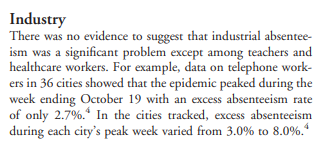In the Asian Flu of 1957-58, They Rejected Lockdowns
By @jeffreyatucker https://www.aier.org/article/in-the-asian-flu-of-1957-58-they-rejected-lockdowns/
By @jeffreyatucker https://www.aier.org/article/in-the-asian-flu-of-1957-58-they-rejected-lockdowns/
The '57-58 flu is estimated to have killed in one year around 100k Americans, or about 200k in today's population terms. The age profile of death was notably younger than Covid, and pregnant women appear to have been one of the high risk categories.
According to this 2009 paper, "The highest attack rates were in school-age children through young adults up to 35 or 40 years of age...It was attributed to the complete absence of protective antibody among children and young and middle-aged adults."
https://pdfs.semanticscholar.org/5a81/5104a7c0380ca6c7b1ecf19952de63b5a673.pdf [pg 7]
https://pdfs.semanticscholar.org/5a81/5104a7c0380ca6c7b1ecf19952de63b5a673.pdf [pg 7]
The '57 flu swept through the US in 3 months, infecting 25% of the population. At ~100k deaths, this represents an IFR of ~0.3%, consistent with SARS-CoV2 IFR for a population with a median age similar to 1957 America (~30yrs).
https://link.springer.com/article/10.1007/s10654-020-00698-1 https://www.cdc.gov/coronavirus/2019-ncov/hcp/planning-scenarios.html
https://link.springer.com/article/10.1007/s10654-020-00698-1 https://www.cdc.gov/coronavirus/2019-ncov/hcp/planning-scenarios.html
The '57-58 flu is considered the 2nd-worst pandemic of the 20th Century. Estimates put its global death toll at 1-5mil. On 2mil, that would be about 5mil in today's population terms. Surely hard to conclude Covid is materially worse than the Asian flu?
https://en.wikipedia.org/wiki/1957%E2%80%931958_influenza_pandemic
https://en.wikipedia.org/wiki/1957%E2%80%931958_influenza_pandemic
Given the severity of the Asian flu, one would expect it had disastrous economic consequences according to the view that viruses do the real economic damage, not lockdowns. But this is not the case. While there was a recession in the US from Sep'57-Jun'58, it was not severe.
The severity of the 1957/58 recession is comparable to most of the post-War US recessions (excluding the 2020 Covid recession), was one of the shortest, and had one of the fastest recoveries back to the prevailing trend. HH consumption barely fell.
If viruses are supposed to be so economically damaging through fear and sickness, the Asian flu didn't live up to this expectation. In the 1957/58 recession, real consumption expenditure did not contract as in subsequent recessions. And work absenteeism was low.
It's remarkable how little influence the Asian flu is thought to have had on the 1957-58 recession. The excerpt below is from the Henderson et al paper [2009]. Probably no more than a 1% GDP impact, hardly distinguishable from normal fluctuations.
https://pdfs.semanticscholar.org/5a81/5104a7c0380ca6c7b1ecf19952de63b5a673.pdf
https://pdfs.semanticscholar.org/5a81/5104a7c0380ca6c7b1ecf19952de63b5a673.pdf
The book-length UN World Economic Surveys of 1957/58 discuss the recession extensively. Yet ZERO mention of the Asian flu pandemic inflicting economic damage. This was clearly just NOT a part of the narrative at all.
1957: https://www.un.org/en/development/desa/policy/wess/wess_archive/searchable_archive/1957_WESS_Full.PDF
1958: https://www.un.org/en/development/desa/policy/wess/wess_archive/searchable_archive/1958_WESS_Full.PDF
1957: https://www.un.org/en/development/desa/policy/wess/wess_archive/searchable_archive/1957_WESS_Full.PDF
1958: https://www.un.org/en/development/desa/policy/wess/wess_archive/searchable_archive/1958_WESS_Full.PDF
While the '57/58 recession doesn't appear to have been preceded by the typical monetary/credit excesses of most recessions (suggesting a non-credit cycle explanation), rising inflation & high durable goods demand & industrial prod. in the mid-50s suggest a malinvestment cycle.
A look at the economic data from the time shows that a slowdown had begun in 1956/early 1957 already, well before H2N2 outbreak. An August 1958 St. Louis Fed analysis of the recession also has absolutely ZERO mention of the effects of a flu pandemic.
https://fraser.stlouisfed.org/files/docs/publications/frbslreview/rev_stls_195808.pdf
https://fraser.stlouisfed.org/files/docs/publications/frbslreview/rev_stls_195808.pdf
This is all quite consistent with this World Bank simulation, which a estimates that a SARS-CoV2-sized pandemic would have a 1-2% global GDP impact.
http://documents1.worldbank.org/curated/en/977141468158986545/pdf/474170WP0Evalu101PUBLIC10Box334133B.pdf
Telling that simulations never considered mass total lockdowns: they didn't form a part of viable policy.
http://documents1.worldbank.org/curated/en/977141468158986545/pdf/474170WP0Evalu101PUBLIC10Box334133B.pdf
Telling that simulations never considered mass total lockdowns: they didn't form a part of viable policy.
Even the 1918/19 Spanish flu had relatively small impacts on the US economy at the time, although probably significantly more impact than 1957/58. This article argues that war effort government spending mitigated the recessionary impact of the flu. https://voxeu.org/article/1918-influenza-did-not-kill-us-economy
But this doesn't seem like a sufficient explanation. War spending had soared since Feb 1917, but peaked during the epidemic and began falling precipitously from Dec 2018 as war efforts deescalated. A better explanation is that the pain period was short and people still worked.
There was no great depression of 1919. Instead, a brutal war that trashed immune systems came to an end, freeing up productive resources. Despite 2mil Americans dying in 1918/19 (in today's population terms), the economy was not smashed, and probably grew. https://voxeu.org/article/1918-influenza-did-not-kill-us-economy
The point of all this is that we've been told that pandemics smash economies from sickness & fear, while mass lockdowns actually save economies. Yet past pandemics and economic analysis prior to 2020 showed that pandemics don't have very large economic impacts on their own.
SARS-CoV2 by itself - without policy hysteria - might have had a 1% global GDP impact, maybe less given the age-graduated nature of its mortality risk. It's hard to conclude anything other than lockdowns cause almost all the economic destruction we've seen so far.
This is relevant b/c even if you argue lockdowns saved lives by alleviating hospital capacity (a tenuous proposition at best), you have to reckon with its enormous effects on human health and wellbeing in the broadest sense. The economy is our most important life-support machine.
Yet, we've seen no compelling evidence that hard lockdowns save lives and improve health. No systematic case made by govts that lockdowns are worth it. Extraordinary infringements upon literally vital liberties require extraordinary evidence.
(Toby Young)
(Toby Young)

 Read on Twitter
Read on Twitter


![It's remarkable how little influence the Asian flu is thought to have had on the 1957-58 recession. The excerpt below is from the Henderson et al paper [2009]. Probably no more than a 1% GDP impact, hardly distinguishable from normal fluctuations. https://pdfs.semanticscholar.org/5a81/5104a7c0380ca6c7b1ecf19952de63b5a673.pdf It's remarkable how little influence the Asian flu is thought to have had on the 1957-58 recession. The excerpt below is from the Henderson et al paper [2009]. Probably no more than a 1% GDP impact, hardly distinguishable from normal fluctuations. https://pdfs.semanticscholar.org/5a81/5104a7c0380ca6c7b1ecf19952de63b5a673.pdf](https://pbs.twimg.com/media/EtMnWunXEAE1AZG.png)




